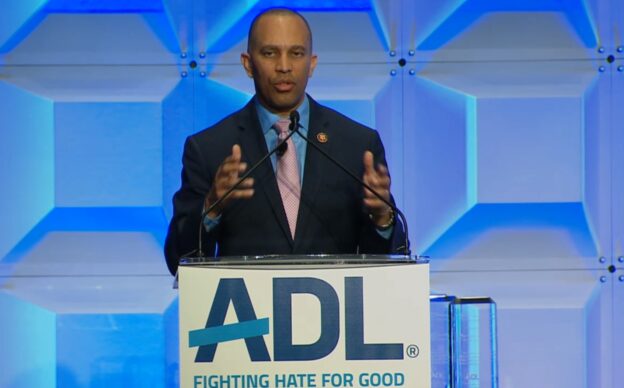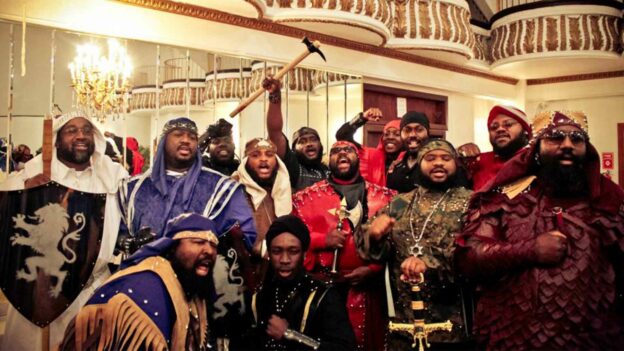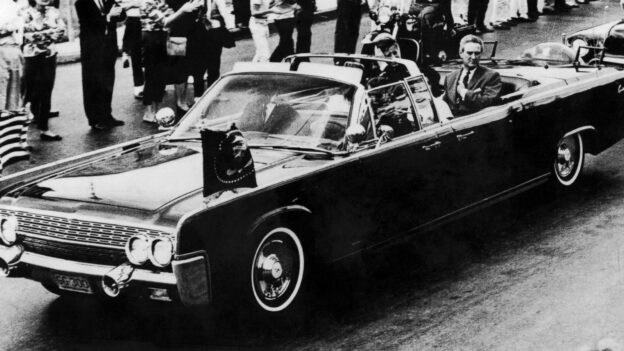
An oldie about Chanukah that appeared in the New York Times can be read here.

Yosef, as an Egyptian viceroy, is so emotionally conflicted as he maltreats his brothers, who don’t recognize him, he has to leave the room to cry (Beraishis, 42:24).
Why he felt he had to persist in his protracted ruse to get his brothers to bring him the youngest of them, Binyamin, his only full brother, why he needed to threaten to imprison his young sibling, is fairly obvious.
To reach the goal of a true reconciliation with the brothers who plotted against, and then sold, him years earlier, Yosef had to ascertain if his brothers had truly repented of their past treatment of him. That would be evident if they now were prepared to protect a younger half-brother – one from the same mother, Rachel, who bore him – at whatever cost.
They passed the test, standing up to the viceroy and showing their readiness to do whatever might be necessary to return Binyamin to his father Yaakov.
The Rambam (Hilchos Teshuvah, 2:1) famously writes:
“What is considered complete repentance? When a person confronts the same situation in which he sinned and has the potential to commit [the sin again] but nevertheless, abstains and does not commit it… not because of fear or a lack of strength.”
In that halacha, the Rambam is codifying what Rav Yehudah says in Yoma, 86b. But neither the Gemara there nor the Rambam indicates the ultimate source in the Torah of that idea.
I suspect it is the account of Yosef and his repentant brothers.
© 2022 Rabbi Avi Shafran

Democratic Congressmen Hakeem Jeffries and Ritchie Torres are two people worth looking at closely. They give the lie to the contention that the blue sky is falling.
To read what I mean, click here.

He refused.
That is the meaning of the word vayima’en, a word used twice in the story of Yosef in this parsha, once to describe a refusal by Yaakov Avinu, the second to describe one by Yosef.
Mourning his missing and presumed killed son for many days, the Torah recounts, Yaakov refused to be comforted (Beraishis 37:35): Vayima’en lihisnachem.
And then, when Yosef, serving as the second-in-command of the house of the Egyptian notable Potifar (ibid, 39:8), is seduced by his master’s wife, he refuses her: Vayima’en, again.
I haven’t been successful in tracking down the source of a suggestion I heard several years ago, but offer it all the same.
It was Yaakov’s refusal to accept that Yosef was no longer alive that enabled Yosef to refuse Mrs. Potifar’s blandishments. The first vayima’en gave power to the second one. It was, in other words, the merit of Yaakov’s love for, and dedication to, his son that empowered that son to overcome a great moral challenge (which he came close to failing, hinted at by the wavering shalsheles with which his vayima’en is chanted).
The lesson being that when we refuse to give up on someone who seems hopelessly “gone” – in whatever way – our very refusal can serve as a spiritual merit for that person, a long-distance and unknown-to-him assistance to him in dealing with adversity.
© 2022 Rabbi Avi Shafran

There’s no “cure” for either idiocy or anti-Semitism (or the common combination of the two). But there are ways of dealing with it, like calling in the comedians.
To read what I mean, see my most recent Ami Magazine column, here.

“As surely as I have established My covenant with day and night – the laws of heaven and earth – so will I never reject the offspring of Yaakov…” (Yirmiyahu 33:25-26)
There are laws of nature, and of human nature. And one of the latter is, according to Rabi Shimon bar Yochai, in a beraisa brought by Rashi (Beraishis 33:4), the “halacha” that “Esav hates Yaakov.”
When the sar shel Esav wrestles with Yaakov, our forefather asks him “Tell me your name” and Seforno comments that the question’s intent was, “What sin of mine allowed you to attack me?”
No answer to the question is recorded or, presumably, offered.
Something poignant inheres in that. When hatred of Jews is manifest, we often try to understand what begat it, what “reason” there is for it. But, even though the haters might claim there are reasons, when looked at closely, their “reasons” are illogical. There’s simply no “there” there.
Because the hatred isn’t “caused” by anything. It just is, as an expression of animus inherent in Esav’s and his spiritual descendants’ essence.
It is, in other words, a law of human nature. And rather than criticize ourselves for doing this or that wrong, or not doing this or that right, we do best to just smile at the demonstration of that “law,” and, even as we fight, as we must, to counter the unwarranted anger and slanders, try to accept that, at least among some people, it will absurdly persist until Mashiach arrives.
And at the same time, we must recognize, too, that, despite Esav’s evil intentions, another “law,” another reality, is that Hashem “will never reject the offspring of Yaakov,” will never allow Esav and his spiritual progeny to win.
© 2022 Rabbi Avi Shafran

If you aren’t familiar with the story of Roddie Edmonds, a Tennessee-born non-Jewish sergeant who fought in World War II and was captured by the Nazis, you can read it here.

What a bizarre reaction Yaakov has when he first sees Rachel, his wife-to-be: He kisses her and loudly cries. (Beraishis, 29:11).
Stranger still, at least at first read, is one of the explanations the Midrash Rabbah offers (and Rashi quotes) for Yaakov’s tears: “Because he foresaw through Divine inspiration that she would not be buried with him in the cave of Machpelah.”
Not the most romantic reaction, to put it mildly. Sort of a “meet morbid.”
But it shines a blazing light on a major disconnect between how contemporary society views love between husband and wife and how the Torah does.
The disconnect is equally evident in the fact that the seven years that Yaakov worked for Lavan before being granted Rachel as a wife were to him like a mere “few days because of his love for her” (ibid 29:20).
As the Malbim notes, a typical suitor would find having to wait seven years to marry his intended interminable. But Yaakov’s experience was the opposite.
Because he saw his attainment of Rachel as his wife not as a quenching of desire but as a calling, a destiny, a mission of love.
A mission whose very end he foresaw in a prophecy, prompting his tears; and his kiss, which, in Yaakov’s mindset, was the epitome of chaste.
As the Kotzker famously remarked, one who “loves fish” doesn’t really love fish; he loves his palate. The true fish lover is an aquarist.
So many in our world today marry out of self-love, not true love of another. They “fall” in love and thus, so often, “fall out” of love. When the two parts of a new couple see each other as partners in working toward a mutual goal, their marriage becomes not an end of love but rather its nurturing.
© 2022 Rabbi Avi Shafran

Fake, fakery, everything’s phony; I sound like a Bible, I do. Yeah, still young, but I’ve lived long enough to smell the smoke and spot the mirrors. Yeah, me, a phony too. Even after all I’ve given, all I’ve been given, all I seem to be, all they think I am, all the hands stretching out, all the love. Smile, wave, turn, smile. Things aren’t what they seem. They’re the opposite, at least sometimes, at least me… Hero, leader, specimen of manhood and health and confidence. Ha. Wave, smile, turn, wave. If they only knew, if they could only see me at three in the morning writhing in pain, crying like a baby for his mother and a breast but me, for the doc and a shot. Mother… mother. And what about my own kids’ mother… What she knows, my quiet, beautiful wife, she knows. What she doesn’t, she doesn’t have to. Geez, she’s lovely… just like the flowers she’s holding… Even after ten years of marriage… Of course she knows. She just accepts things… the life is just worth it to her, even with me… but she deserves better. She’s suffered enough, with father, with Rose. And the baby, years ago. And the baby now. She doesn’t need more pain dumped on her pile. Let her take some pride in her life, her children. In me, even, even if it’s misplaced… A sham, I am. Even my words aren’t mine. They’re mostly Chaiken’s – ha, Teddy hates it when I call him that. He’s great, though, a brainy tongue. My brainy tongue. It’s him talking, though. I’m just the mannequin moving my mouth, smiling. But a mannequin who screams his own screams at night, who has a “condition.” Ha. Funny word. Turn, wave, smile. Condition’s what you do to the air when it’s hot in a room. Yeah. Smile, wave. Man, it’s hot here today. Doesn’t fall ever come to Texas? Sweat doesn’t look good, even on a good looking mannequin. Hope the smile draws their eyes to my teeth, not my forehead. Wave, turn, smile, turn, wave. Dangerous and uncertain world, yeah, but friendly crowd. Guess the sign’s right. Dallas loves me. Ha. It just doesn’t kno—

“I’m forty years old.” Esav said to himself (Beraishis 26:34). “Father was 40 when he got married,” he rationalized, according to Rashi. “I should do the same.” (The pasuk itself just notes Esav’s age and marriage, not the rationale.)
The Mei Marom (R’ Yaakov Moshe Charlop) notes the cognitive dissonance evident in Esav’s aspiring to follow his father Yitzchak’s matrimonial path. Ever since his teenage years, after his grandfather Avraham had died, Esav’s proclivities had included murder and rape (Bava Basra 16b). And now, decades on, he sees himself as properly following in his father’s footsteps?
That seems indeed to be the case, and that fact, says Rav Charlop, reveals a strange but real psychological truth: People can live lives entirely devoid of holiness and yet convince themselves that, somehow, by merely mimicking holy people, they thereby achieve some holiness.
We see that in, for example, the adoption of personal customs associated with revered figures when the adopters have nothing in common with the lives of those customs’ originators.
Reciting a special group of Tehillim each morning, kissing the Torah three times or insisting on a particularly rarified level of kashrus are fine things to do. But not if they are seen as meaningful in-and-of-themselves, even in the absence of true effort to achieve a higher level of actually required observance. Not if they are thought of, so to speak, as “get out of jail free” cards.
How astonishing, remarks Rav Charlop, is this element of human psychology. And how important is the real work required to achieve truly meaningful, not illusory, growth.
Esav had every right to seek a wife. Just like a pig, to which he is compared, has every right to present his split-hooves credentials. But neither the wife nor the hooves make either one kosher.
© 2022 Rabbi Avi Shafran